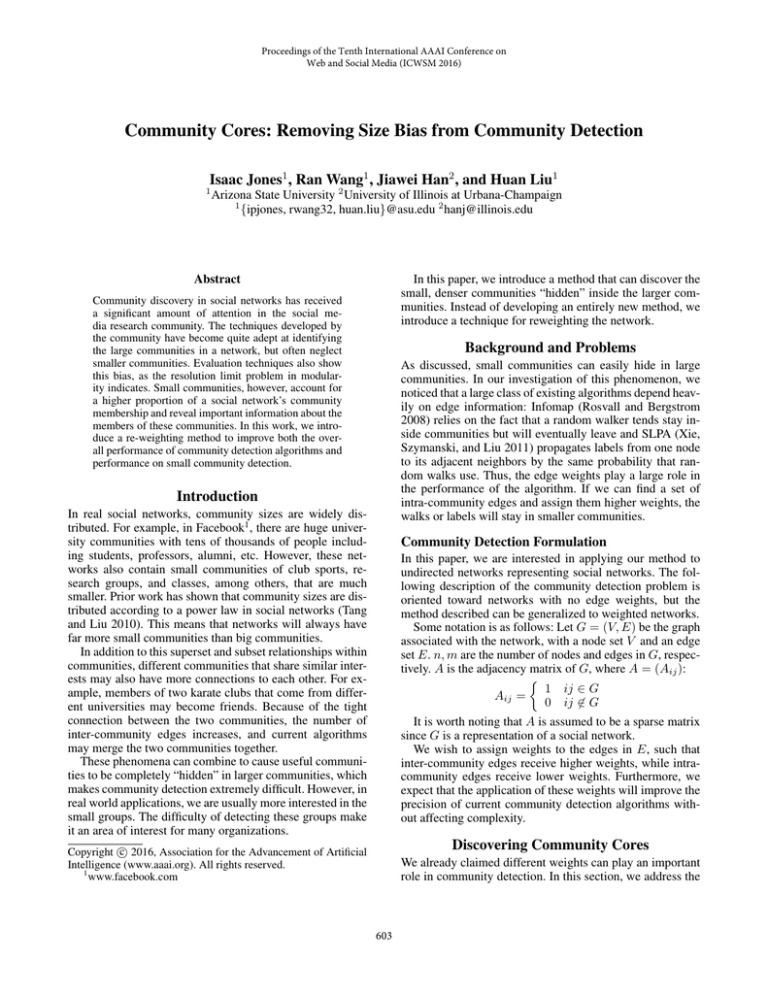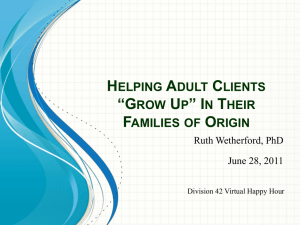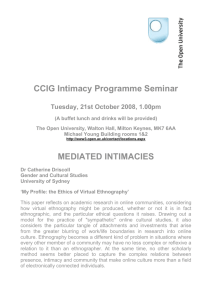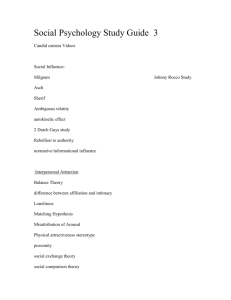
Proceedings of the Tenth International AAAI Conference on
Web and Social Media (ICWSM 2016)
Community Cores: Removing Size Bias from Community Detection
Isaac Jones1 , Ran Wang1 , Jiawei Han2 , and Huan Liu1
1
Arizona State University 2 University of Illinois at Urbana-Champaign
1
{ipjones, rwang32, huan.liu}@asu.edu 2 hanj@illinois.edu
In this paper, we introduce a method that can discover the
small, denser communities “hidden” inside the larger communities. Instead of developing an entirely new method, we
introduce a technique for reweighting the network.
Abstract
Community discovery in social networks has received
a significant amount of attention in the social media research community. The techniques developed by
the community have become quite adept at identifying
the large communities in a network, but often neglect
smaller communities. Evaluation techniques also show
this bias, as the resolution limit problem in modularity indicates. Small communities, however, account for
a higher proportion of a social network’s community
membership and reveal important information about the
members of these communities. In this work, we introduce a re-weighting method to improve both the overall performance of community detection algorithms and
performance on small community detection.
Background and Problems
As discussed, small communities can easily hide in large
communities. In our investigation of this phenomenon, we
noticed that a large class of existing algorithms depend heavily on edge information: Infomap (Rosvall and Bergstrom
2008) relies on the fact that a random walker tends stay inside communities but will eventually leave and SLPA (Xie,
Szymanski, and Liu 2011) propagates labels from one node
to its adjacent neighbors by the same probability that random walks use. Thus, the edge weights play a large role in
the performance of the algorithm. If we can find a set of
intra-community edges and assign them higher weights, the
walks or labels will stay in smaller communities.
Introduction
In real social networks, community sizes are widely distributed. For example, in Facebook1 , there are huge university communities with tens of thousands of people including students, professors, alumni, etc. However, these networks also contain small communities of club sports, research groups, and classes, among others, that are much
smaller. Prior work has shown that community sizes are distributed according to a power law in social networks (Tang
and Liu 2010). This means that networks will always have
far more small communities than big communities.
In addition to this superset and subset relationships within
communities, different communities that share similar interests may also have more connections to each other. For example, members of two karate clubs that come from different universities may become friends. Because of the tight
connection between the two communities, the number of
inter-community edges increases, and current algorithms
may merge the two communities together.
These phenomena can combine to cause useful communities to be completely “hidden” in larger communities, which
makes community detection extremely difficult. However, in
real world applications, we are usually more interested in the
small groups. The difficulty of detecting these groups make
it an area of interest for many organizations.
Community Detection Formulation
In this paper, we are interested in applying our method to
undirected networks representing social networks. The following description of the community detection problem is
oriented toward networks with no edge weights, but the
method described can be generalized to weighted networks.
Some notation is as follows: Let G = (V, E) be the graph
associated with the network, with a node set V and an edge
set E. n, m are the number of nodes and edges in G, respectively. A is the adjacency matrix of G, where A = (Aij ):
1 ij ∈ G
Aij =
0 ij ∈ G
It is worth noting that A is assumed to be a sparse matrix
since G is a representation of a social network.
We wish to assign weights to the edges in E, such that
inter-community edges receive higher weights, while intracommunity edges receive lower weights. Furthermore, we
expect that the application of these weights will improve the
precision of current community detection algorithms without affecting complexity.
Discovering Community Cores
c 2016, Association for the Advancement of Artificial
Copyright Intelligence (www.aaai.org). All rights reserved.
1
www.facebook.com
We already claimed different weights can play an important
role in community detection. In this section, we address the
603
Input: Original network adjacency matrix A
Output: Intimacy matrix I
Choose a set T of k samples of positive pole and
negative poles
for each s ∈ T do
Solve v in linear equation (D − A)v(st) = b(st) .
Calculate current-flow betweenness cij for all edges
ij
end
Find cmin = min(cij ), cmax = max cij .
Calculate S = cmax + cmin .
for each edge ij ∈ E do
Compute Iij = S − cij
end
for each pair (i, j) with Aij = 1 do
Iij = Iij + end
Algorithm 1: Intimacy Calculation
two problems proposed earlier.
Choosing an appropriate reweighting method is not easy
or obvious. Edge betweenness centrality is a strong candidate since Girvan and Newman already use it as a technique
for detecting communities in their classical algorithm.
Selecting edge betweenness gives us two subsequent
problems to solve. First, edge betweenness measures intercommunity edges with higher weight, while we need these
edges to be lower weight. Second, the complexity for calculating betweenness is O(n3 ), which is infeasible. The first
problem is simpler to solve, and is addressed later. We solve
the second problem by approximating current-flow betweenness, as introduced by (Newman and Girvan 2004).
Betweenness Centrality
Approximating current-flow betweenness can also be done
by approximating spanning-tree betweenness. Spanningtree betweenness is a measure of edge betweenness that
measures the number of spanning trees on which each
edge lies. This spanning-tree betweenness is equivalent to
current-flow betweenness according to (Mavroforakis et al.
2015) and demonstrated in (Bollobás 1998). In addition to
reiterating this equivalence, the former also describes a efficient way to compute this betweenness. For brevity, we
omit the exact algorithm and discussion of the algorithm’s
working. In summary, the algorithm uses a sampling technique to approximate current-flow betweenness and a fast,
approximate linear equation solver to solve Kirchoff’s Laws.
These two approximations reduce the computation’s
com
plexity from O(n3 ) to Õ(m log2 n log 1 ), where is the
error of both approximations.
of 3.54 × 10−8 . The second, a pair comparison test, varied the level of community overlap and showed that intracommunity edges had greater values than inter-community
edge with greater than 50% probability until more than 80%
of the community overlapped. From these tests, we can conclude that intimacy does, in fact, distinguish edge types.
Incorporating Intimacy
Since Intimacy can be computed quickly and differentiates
edge types, we can integrate the intimacy measure into common community detection algorithms.
1. Infomap (Rosvall and Bergstrom 2008). Using the properties of Random Walks, this algorithm generates a number
of modules and then optimizes communities by combining and separating these modules in such a way that minimizes the map equation.
Measuring Intimacy
Using these edge centrality metrics, we can then move on
to actually reweighting the network. We define the measure
that we will use to reweight the network as Intimacy:
2. Speaker-listener Label Propagation Algorithm (SLPA)
(Xie, Szymanski, and Liu 2011). Proceeding iteratively,
SLPA gives all nodes labels a gives a node’s label to each
of its neighbors and then repeats. After all iterations are
complete, labels above a given threshold are kept.
Definition 1 (Intimacy) In a network, the intimacy measure for each edge ij ∈ E(G) is a real number Iij that
is inversely proportional to its betweenness measure cij :
Iij := max cij + min cij − cij
i,j
i,j
3. Louvain’s algorithm (Blondel et al. 2008). A very popular
modularity optimization method, Louvain’s algorithm is
an agglomerative heuristic algorithm.
To calculate intimacy, we first calculate the betweenness
measure over the entire network, which can be done quickly
thanks to the work in the previous section. From the description above, Algorithm 1 formalizes the procedure.
In the final step of this algorithm, we add an additional
term to ensure that every edge in the network has at least
some intimacy.
To incorporate our method into these algorithms, we simply apply the original method on the reweighted network.
Experimental Results
Datasets
The data we use for our experiments are as follows, with
statistics given in Table 1.
Intimacy Verification
In order to demonstrate that intimacy does, in fact, distinguish between inter- and intra-community edges, we performed two test of intimacy values. The first, a MannWhitney-Wilcoxon (Mann, Whitney, and others 1947) test,
demonstrated that inter- and intra- community edges had
substantially different distributions with a maximum p-value
• LFR Benchmark network (Lancichinetti, Fortunato, and
Radicchi 2008). The LFR benchmark is not a single data
set, but an algorithm for generating datasets. This algorithm for generating datasets allows the user to control a
large number of features of the output graph.
604
Network
Amazon
Youtube
DBLP
Nodes
334,863
1,134,890
317,080
Edges
925,872
2,987,624
1,049,866
Communities
271,270
8,385
13,477
Table 1: Real-world dataset statistics
• Amazon Co-Purchasing Network (Leskovec and Krevl
2014): The Amazon Co-Purchasing Network is based on
the ‘Customers Who Bought This Item Also Bought’ feature. Two products, nodes, are linked if they are frequently
purchased together.
• YouTube (Leskovec and Krevl 2014): The YouTube network is based on user-defined groups on the YouTube2
video sharing site. User groups form the ground-truth
community assignments.
• DBLP (Leskovec and Krevl 2014): The DBLP network is
based on collaboration between researchers in Computer
Science. In this network, the ground-truth communities
are determined by publication venue.
(a) NMI
The sizes of these datasets can be found in Table 1.
Results
Previously, we demonstrated that our intimacy measure effectively distinguishes edge type by their values. We will
next demonstrate the performance-increasing potential of
the intimacy reweighting technique. To judge the level
of improvement, we will be evaluating community partitions using Generalized Normalized Mutual Information
(GNMI) (Lancichinetti, Fortunato, and Radicchi 2008). We
chose GNMI since standard NMI does not properly handle overlapping communities. An implementation of this
method can be found online3 .
Our evaluation depicted in Figure 1 took place on synthetic networks generated using the LFR benchmark. In
these synthetic networks, we varied a number of parameters, including the network size (N ), number of nodes in
overlapping communities (On ), number of communities to
which nodes with overlap belong (Om ), and the topological
mixing parameter (μ). We use 2 for the power-law degree
constants for both community sizes and node degree distributions and 25 for the average node degree in all instances.
To ensure that our results are consistent we use 30 network
realizations and plot the average.
Figure 1 shows the results of combining our reweighting
technique with the SLPA algorithm. In all subgraphs, we
show the base algorithm’s performance (blue), the base algorithm with intimacy reweighting (red), and the base algorithm with random reweighting (black). Random reweighting occurred by selecting edge weights randomly from the
uniform distribution of [1, 5]. Figure 1(a) clearly shows that
the NMI of community partitions increases when the network is reweighted with intimacy. Figure 1(b) additionally
2
3
(b) Community average size
Figure 1: Synthetic results: SLPA
shows that average community sizes decrease or remain
approximately the same when the network is reweighted.
These together show that the communities detected after the
network is reweighted are smaller on average and that these
smaller communities are more accurate to the ground truth.
In addition to reweighting on SLPA, we also performed
experiments with Infomap, which uses some global information. Infomap maximizes the map equation to find its final partitions, which uses global information. Under these
conditions, reweighting with intimacy does not provide as
strong a result as it does with SLPA.
Since our method shows promising results on these synthetic networks, we next look to the real-world data sets.
Table 2 shows the results of testing these combinations. Our
www.youtube.com
https://sites.google.com/site/andrealancichinetti/mutual
605
Network
Amazon
Youtube
DBLP
SLPA(no)
0.242
0.024
0.130
SLPA(in)
0.273
0.018
0.143
SLPA(rn)
0.250
0.013
0.132
IMP(no)
0.226
0.004
0.096
IMP(in)
0.226
0.006
0.096
IMP(rn)
0.224
0.005
0.091
LVA(no)
0.280
0.027
0.150
LVA(in)
0.285
0.026
0.149
LVA(rn)
0.263
0.018
0.136
Table 2: NMI results for Infomap (IMP), SLPA, and Louvain’s algorithm (LVA) on real-world networks with no reweighting
(no), random reweighting (rn), and intimacy reweighting (in).
in community detection is Evolving Community Detection.
Additional ability to to detect communities earlier in their
course of course may assist with the task of detecting these
evolving, highly dynamic communities.
results here are similar to the ones obtained on synthetic networks with two exceptions. The first, SLPA and intimacy
on the YouTube network is interesting, as any reweighting
degrades performance. This pattern is not repeated, so it is
unclear why SLPA performs so well. The second anomaly
exists with Louvain’s algorithm on the YouTube and DBLP
networks. In this case, we see performance degradations
when reweighting. We believe that this is because the final step of Louvain’s algorithm uses modularity to determine the optimal partition. Scaling up the network to these
sizes likely caused modularity to combine some of the new,
smaller communities together due to its resolution limit, resulting in a lower NMI. Since the communities in our synthetic networks were large relative to the size of the network,
this did not occur in our synthetic results.
These results indicate that our intimacy reweighting technique does provide strong, positive results across a wide variety of network topologies, though the technique works better as the size and complexity of the network increase. In
addition, the technique is more effective when used alongside algorithms that do not take global information into account, like SLPA and Louvain’s algorithm. Algorithms that
use global information like Infomap can benefit, although
not as much.
Acknowledgments
The authors would like to acknowledge the contributions of
all of the members of ASU’s DMML. Research was sponsored in part by the U.S. Army Research Lab. under Cooperative Agreement No. W911NF-09-2-0053 (NSCTA).
References
Blondel, V. D.; Guillaume, J.-L.; Lambiotte, R.; and Lefebvre, E. 2008. Fast unfolding of communities in large networks. Journal of Statistical Mechanics: Theory and Experiment 2008(10):P10008.
Bollobás, B. 1998. Modern graph theory, volume 184.
Springer Science & Business Media.
Lancichinetti, A.; Fortunato, S.; and Radicchi, F. 2008.
Benchmark graphs for testing community detection algorithms. Physical Review E 78(4):046110.
Leskovec, J., and Krevl, A.
2014.
SNAP
Datasets: Stanford large network dataset collection.
http://snap.stanford.edu/data.
Mann, H. B.; Whitney, D. R.; et al. 1947. On a test
of whether one of two random variables is stochastically
larger than the other. The annals of mathematical statistics
18(1):50–60.
Mavroforakis, C.; Garcia-Lebron, R.; Koutis, I.; and Terzi,
E. 2015. Spanning edge centrality: Large-scale computation and applications. In Proceedings of the 24th International Conference on World Wide Web, 732–742. International World Wide Web Conferences Steering Committee.
Newman, M. E., and Girvan, M. 2004. Finding and evaluating community structure in networks. Physical review E
69(2):026113.
Rosvall, M., and Bergstrom, C. T. 2008. Maps of random walks on complex networks reveal community structure. Proceedings of the National Academy of Sciences
105(4):1118–1123.
Tang, L., and Liu, H. 2010. Community detection and mining in social media. Synthesis Lectures on Data Mining and
Knowledge Discovery 2(1):1–137.
Xie, J.; Szymanski, B. K.; and Liu, X. 2011. Slpa: Uncovering overlapping communities in social networks via a
speaker-listener interaction dynamic process. In Data Mining Workshops (ICDMW), 2011 IEEE 11th International
Conference on, 344–349. IEEE.
Guidelines
Effectively applying this intimacy reweighting technique
can be situational. Since our technique operates faster than
the base community detection algorithms, it can be applied
without affecting computational complexity. Our technique
works best when the algorithm of choice does not use global
information. In addition, using a modularity-based technique may hamper performance on some networks. That
said, our method does result in smaller detected communities across detection methods and network types, so it may
be valuable if small communities are the goal.
Conclusion
This paper develops a new reweighting measure to improve
the performance of existing community detection methods
without compromising complexity. The reweighting technique finds global information in near linear time, and has
a wide range of applications. Applying this technique shows
gains in local-information based methods, like SLPA.
Our work also shifts the focus of common community detection algorithms from large communities to small communities. Handling small communities may have impacts outside of improving community detection results and matching community size distributions. One emerging problem
606






